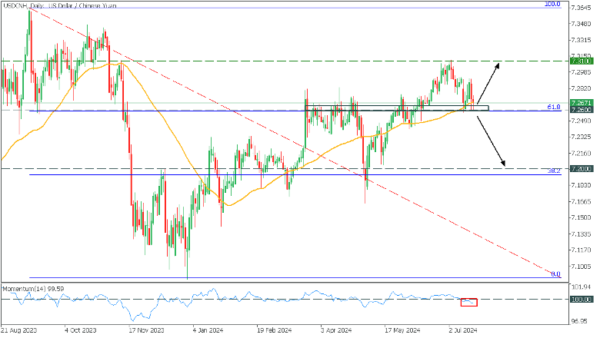The USDCNH pair represents the exchange rate between the US dollar and the Chinese yuan. Factors influencing the US dollar include Federal Reserve policies, inflation rates, and the overall health of the US economy. In contrast, the Chinese yuan is affected by China’s monetary policies, economic growth metrics, and regulatory changes impacting capital flows. Movements in this currency pair can provide insights into shifts in economic policies, trade balances, and broader geopolitical tensions between the USA and China.
US Existing Home Sales, July 23, 16:00 (GMT+2)
The forthcoming release of US existing home sales predicted to decline to 4 million from 4.11 million, serves as a critical economic indicator. If the actual sales figures exceed expectations, suggesting a more robust housing market than anticipated, it could enhance investor confidence in the US economy. A strong real estate sector often correlates with broader economic strength, potentially boosting the US dollar and consequently driving the USDCNH pair higher. However, if the figures are lower than forecast, indicating a sluggish housing market, it could undermine confidence in the economic recovery, leading to a depreciation of the dollar against the yuan and a drop in the USDCNH rate.
CB Leading Index m/m, July 25, 15:00 (GMT+2)
The CB Leading Index from China measures economic activity and is forecasted to show a reduced contraction of -0.3%, an improvement over the previous -0.5%. If the index outperforms expectations by showing minimal contraction or unexpected growth, it would indicate an improving outlook for China’s economy. A more robust Chinese economy usually bolsters the yuan, potentially lowering the USDCNH exchange rate as the yuan appreciates against the dollar. Conversely, a greater-than-expected decline in the index would suggest a sharper slowdown, potentially weakening the yuan. In such a case, the USDCNH pair might rise as the dollar strengthens relative to a faltering yuan, reflecting increased concerns over China’s economic trajectory.
In the Daily timeframe, USDCNH is in a long-term uptrend. After a minor correction, the price fell to the 61.8 Fibonacci support, testing the MA50. Despite the long-term rise, Momentum fell below 100.0, which requires considering two possible scenarios.
- If the bears push the price below MA50 and 7.2600, the drop will be to 7.2000;
- However, a rebound from support would bring USDCNH back to resistance at 7.3100;










